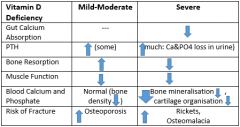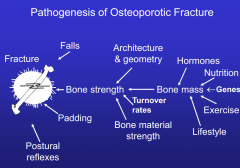![]()
![]()
![]()
Use LEFT and RIGHT arrow keys to navigate between flashcards;
Use UP and DOWN arrow keys to flip the card;
H to show hint;
A reads text to speech;
16 Cards in this Set
- Front
- Back
|
What is osteoporosis? |
A progressive bone disease characterised by a decrease in bone mass and density which leads to an increase in fracture risk. The BMD is reduced, microarchitecture deteriorates and the amount and variety of proteins are altered. Associated with a BMD < -2.5 SD as measured by DEXA. |
|
|
Explain the concept of coupling. |
Coupling is the balance of bone resorption and bone formation that allows for the maintenance of adequate bone mass. |
|
|
What are the factors affecting bone mass? |
Age Gender Mechanical loading Mineral balance Vitamin D PTH Sex steroids Smoking, alcohol, glucocorticoid use |
|
|
At what age is peak bone density usually reached and what factors affect this value? |
~25 years
Genes Exercise Calcium intake Vitamin D Normal sex steroids |
|
|
Which 2 factors determine the bone mass of adults? |
Peak bone density Rate of loss |
|
|
What is the relationship between bone mass/density and fracture risk? Illustrate this with reference to the T-score and DEXA. |
There is a non-linear positive relationship between bone desnity and fracture risk.
T-score 0.0 to -1.0 normal bone density T-score -1.0 to -2.5: Osteopaenia T-score below -2.5: Osteoporosis |
|
|
What factors determine fracture risk? |
Bone mass Bone quality -dead cells -unrepaired microfractures -connectivity: loss of horizontal struts between trabeculae -rates of bone turnover: eg: resorption cavities (mechanical stress concentrates here) -degree of mineralisation Bone geometry (primarily, size) -bone is more able to resist bending and torsion with greater diameter (What Warwick said) Propensity to fall -muscle function -coordination |
|
|
How does mechanical loading maintain bone mass? |
Wnt pathway in bone: Wnt signalling increases transcription of genes involved in bone formation.
This pathway is inhibited by sclerostin, which is secreted by osteocytes.
Bone deformity on loading inhibits sclerostin activity and thus facilitates the Wnt pathway. |
|
|
Why is adequate vitamin D a requirement for normal musculoskeletal development? |
For calcium absorption from the diet To mineralise bones For normal muscle function |
|
|
What are the effects of mild-moderate and severe vitamin D deficiency? |

|
|
|
How do low calcium and vitamin D levels lead to reduced bone density? |
Low calcium and Vitamin D --> Increased PTH --> Increased bone resorption --> Reduced bone density (especially cortical bone) |
|
|
What has been discovered about intermittent exposure to PTH? |
Intermittent PTH stimulates the anabolic effects of osteoblasts, with a limited effect on osteoclasts (no increase in bone resorption).
It is unclear why, though it is suggested that sclerostin is inhibited, allowing Wnt signalling to increase bone formation. |
|
|
What effect do oestrogens have on bone? |
Oestrogens inhibit the apoptosis of osteoblasts and osteoclasts. They have antiresorptive properties and reduce the rate of bone turnover. There is some evidence of increased formation. |
|
|
Oestrogens and androgens help maintain coupling. What contributors to fracture risk are affected by sex steroid levels? |
Bone Quality -Dead cells (prevention of apoptosis) -Connectivity -Rates of bone turnover Bone Geometry |
|
|
How do glucocorticoids affect bone mass? |
-Gut: reduced calcium absorption -Kidney: increased calcium losses -Muscle: protein catabolism, causing further calcium loss -Bone: reduced number of replaced osteoblasts and osteoblast viability (increased apoptosis). Inihibits the production of osteocalcin by osteoblasts, which has a positive feedback effect and promotes bone formation. -Reduced IGF-1 -Reduced formation -Suppressed engogenous sex steroid production
--> Reduced bone mass |
|
|
Pathogenesis of an Osteoporotic Fracture |

|

